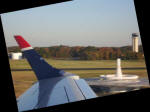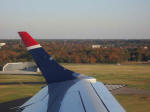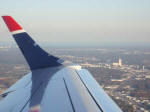

An Airport Ambassador captures
Ruth and Joe at Norfolk International, Virginia.
Ruth and Joe’s Twelfth Wedding Anniversary Day Trip on US Airways, November 10, 2008: Photos and Ruth's Haiku
We flew to visit Norfolk Botanical Garden on the 10th day of the 11th month on our 12th anniversary (10 11 12). The Garden is celebrating its 70th anniversary (1938 - 2008)!
While Ruth walked from Norfolk airport to the Garden during layovers as an off-duty crewmember, our first visit together came to be today. We sat in the sunshine at Friendship Pond with its gorgeous fountain and ate the gourmet picnic lunch we had packed.
After strolling through lovely garden paths and enjoying a tram tour of the trails, we bought a delicious slice of chocolate cake at the Garden Café to share on the terrace overlooking the tranquil Japanese Garden. The weather was cloudless and delightful, the scenery peaceful and gorgeous, and the locals nice and friendly. Airplanes coming and going were full this day (Veterans Day weekend), and we were very thankful we had seats—together—on our selected flights.
At 2:30 in the afternoon we exited the Garden Gate, headed back to check in for our 3:45 p.m. - 5:02 p.m. flight home, and arrived comfortably and safely in plenty of time for our chiropractor Dr. Marc Surprenant's 7 p.m. Dinner with the Doc at the upscale Ballantyne Village, catered by Southpark's Earth Fare. A wonderful stress-free conclusion to a marvelously beautiful day celebrating a dozen years of our marriage!
Pause the mouse on a picture for its caption. Click a photo to enlarge, & a title to jump to the photo series.
The Title Photos:
|
|
|
|
|
|
|
|
|
|
| ___________________________________________________ | |||
| "The mission of Norfolk Botanical Garden is to enrich life by promoting the enjoyment of plants and environment through beautiful gardens and educational programs." | |||
| ___________________________________________________ | |||
| Mirror Lake, at the Norfolk Botanical Garden Historic Area [Return to Title Photos] | |||
|
|
|
|
|
|
|
|
|
|
| ___________________________________________________ | |||
| Hofheimer Camellia Garden [Return to Title Photos] | |||
|
|
|
|
|
|
|
|
|
|
|
|
|
|
|
| ___________________________________________________ | |||
|
|
|
|
|
| ___________________________________________________ | |||
|
Renaissance Garden & Coronation Court [Return to Title Photos] |
|||
|
|
|
|
|
| ___________________________________________________ | |||
|
NATO Tower and Bicentennial Rose Garden [Return to Title Photos] |
|||
|
|
|
|
|
| ___________________________________________________ | |||
|
|
|
|
|
|
|
|
|
|
| ___________________________________________________ | |||
|
|
|
|
|
|
|
|
|
|
|
US973ORFCLT: Taxi [Return to Title Photos] |
|||
|
|
|
|
|
| ___________________________________________________ | |||
 |
 |
 |
|
|
US973ORFCLT: Climb to Altitude [Return to Title Photos] |
|||
|
|
 |
|
|
Most browsers (like Internet Explorer) display all 68 hover captions accompanying these scenes with picturesque prose.
Our twelfth wedding anniversary Norfolk Botanical Garden visit portrayed in poetry:
Airport Garden Stay:
Fall foliage, flowers, fountains,
Round trip in one day.
Photos and Webpage: (of and by) Ruth and Joe